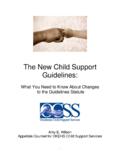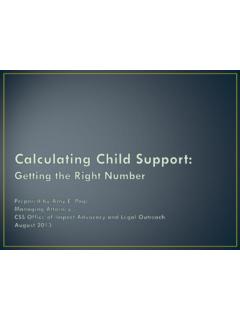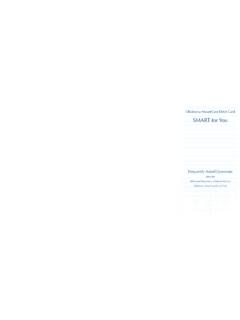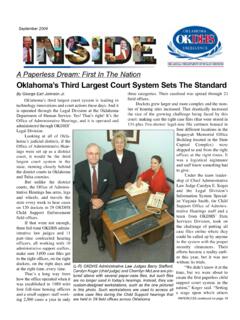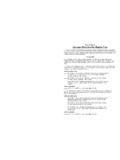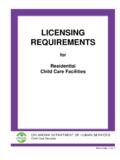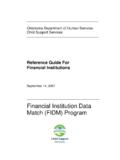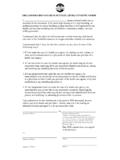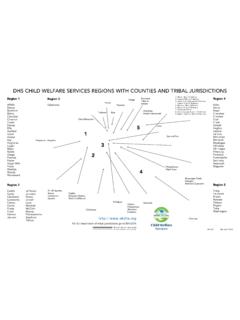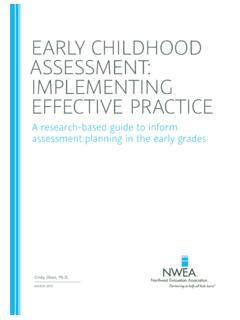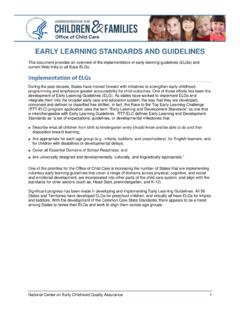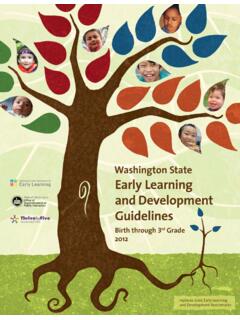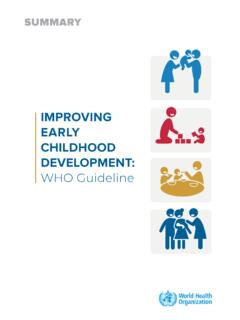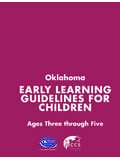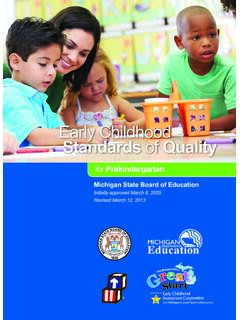Transcription of Early Learning Guidlines for Infants, Toddlers and Twos
1 10-23_rev 11_11 OCCS_OK Early Learning :Layout 1 12/19/11 12:59 PM Page 1 OklahomaEARLY LEARNINGGUIDELINES FORINFANTS, TODDLERSAND TWOSAges 0 through 36 monthsOklahomaEARLY LEARNINGGUIDELINES FORINFANTS, TODDLERSAND TWOSAges 0 through 36 months_____ _____ _____ _____ _____ _____ _____ _____ _____ _____ _____ _____ _____ _____ Table of ContentsINTRODUCTION 1 CONCEPT AREAS 1 APPROACHES TO Learning 6 2 CREATIVE SKILLS (LANGUAGE ARTS) 10 3 COMMUNICATION SKILLS AND Early LITERACY 14 4 MATHEMATICS 26 5 PHYSICAL DEVELOPMENT 33 6 HEALTH AND SAFETY 46 7 SCIENCE 50 8 SOCIAL AND EMOTIONAL DEVELOPMENT 58 9 SELF AND SOCIAL AWARENESS 67 ADDITIONAL RESOURCES 72 GLOSSARY 74 REFERENCES 77 FEEDBACK FORM 80 stars INTRODUCTIONO klahoma Early Learning GuidelinesA taskforce convened by the Oklahoma Department of Human Services Child Care Services developed the Oklahoma Early Learning guidelines .
2 Taskforce members included representatives from the Center for Early childhood Professional Development, Oklahoma Child Care Resource and Referral Association and its affiliates, Oklahoma Department of Career Technology Education, Oklahoma Head Start/ Early Head Start, Oklahoma State Department of Education, Oklahoma State Department of Health, Oklahoma State Regents for Higher Education, Oklahoma Tribal Child Care Association, child care programs, community colleges and universities. This document has been developed to be used by all who touch the lives of Oklahoma s infants, Toddlers and two year olds. The word teacher is used in the guidelines to represent parents, family members, educators, caregivers, program staff and caring adults who offer instruction, support and guidance to young children.
3 These guidelines are intended to assist parents, child care teachers and other caring adults (at all levels of knowledge and experience) regarding what children may know and be able to do. The purpose is to enhance Learning experiences for Oklahoma s youngest children and help provide a safe, nurturing and developmentally appropriate environment. The Early Learning guidelines provide examples of experiences that can be used to build relationships, develop purposeful play and guide program development. They should not be used as a curriculum or assessment. Infants, Toddlers and two year olds are born ready to learn, and their capacity to learn is enriched by the teacher. Situations will arise throughout the day that can be considered teachable moments or unplanned Learning opportunities. These guidelines will assist parents and teachers in finding new ways to introduce everyday experiences and enhance teachable moments.
4 Each section includes an area that will help the parent and teacher provide Learning experiences. When or if materials are needed they may be purchased or homemade. PurposeThe Oklahoma Early Learning guidelines for Infants, Toddlers and Twos were created to serve as a foundation to connect what is taught with what is appropriate for very young children. They also provide a framework to encourage consistency among Early childhood programs across Oklahoma. These guidelines align with the Oklahoma Early Learning guidelines for Children Ages Three through Five, the Priority Academic Student Skills and Early Head Start Performance Standards. The guidelines are a resource that includes commonly held expectations and widely accepted best practices for children in various age groups. At the same time, the guidelines are flexible enough to meet the needs of individual children and groups.
5 Guiding Principles:This document presents a broad view of the child development continuum that reflects commonly used and widely held expectations so that teachers as well as parents can plan for typical developmental progression. The guiding principles are as follows: Value the parents as the child s first teacher. Respect that every child develops as an individual and at his/her own pace. From the time the embryo is forming to the time the child is three years old, rapid growth and development occurs. All Learning and interactions with adults that take place during this time pave the way for future success of the child, both developmentally and in preparation for school and life. All of a child s development (social/emotional, gross/fine motor, cognitive and language) is woven together to complete the whole child.
6 Children learn through self initiated play and teacher directed activities that are developmentally appropriate. Recognize that close relationships between teacher and child are developed during routine caregiving activities (such as diapering and feeding). Respect the child s family and recognize that culture (language, traditions, etc.) influences who the child is and who he/she will become. This must be embraced as part of the child s Early Learning Knowledge and responsiveness to the child and his/her family is key to positive growth and development in the child. Knowledgeable teachers who apply understanding of child development are essential to enhance a child s Learning . Each child s basic needs (health, safety and nutrition) mustbe met for the best possible Learning to of a Quality Program for Infants, Toddlers and Twos:The following practices are necessary to provide a quality program for infants, Toddlers and twos.
7 These elements provide the critical foundation for human development and life long Learning , therefore all aspects of a program must be thoughtfully and deliberately Family Relationship1. Teachers understand and respect the family as the primary source of knowledge concerning the child. 2. Teachers understand the importance of parent child attachment and support the family child relationship. 3. Teachers and families are partners in ongoing communication about the child s care and development. 4. Teachers respect and support family preferences, culture and values in teaching behaviors. 5. Teachers develop relationships that are supportive of the whole family. Teachers assist and encourage family members in developing parenting skills, understanding the growth and development of their children and accessing community resources.
8 6. Teachers learn about the family s cultural practices related to caregiving routines such as feeding, sleeping/naps and encouraging children to gain Child Relationship1. Teachers nurture and respond to the individual needs of infants, Toddlers and twos. Trust and emotional security develop when very young children are responded to promptly and consistently in a positive Teachers knowledge of child development is used to provide appropriate interactions with very young children throughout the day. They learn and respond to each child s unique way of communicating; respond to the child s interests; give the child individualized attention, especially during caregiving routines; and model the behavior they want to teach. 3. The program supports positive relationships and secure attachments between the caregiver and infants, Toddlers and twos by providing low adult/child ratios, promoting continuity and responsive caregiving, and assigning a primary teacher for each child.
9 Child Child Relationship1. Teachers model appropriate interactions with adults and with Teachers recognize emerging social skills and respect the limitations of very young children. Positive relationships between children are Opportunities for socialization are offered through various Both indoor and outdoor materials and equipment meet the developmental needs of each child in the group in a safe and healthy The physical environment provides separate and appropriate space for sleeping, eating, diapering/toileting, hand washing, and for movement and play. The atmosphere is homelike and comfortable for infants, Toddlers and the adults who care for The physical environment for Toddlers provides interest areas where materials with similar use are placed together. Child sized furnishings are provided to promote independence and self help The daily program includes materials and activities that are designed to meet the individual needs of each child.
10 Children are assisted with toilet Learning and self feeding skills based on individual needs. Children experience appropriate transitions between activities. 2. Prevention and redirection are the primary techniques for guiding behavior. Management of behavior is based on an understanding of infant/toddler development, realistic expectations and appropriate methods to help the child develop his or her own self control. 3. Teachers support the child s emerging self regulation through the environment, daily routines, positive role modeling and assisting with the development of communication skills. Health and SafetyNutrition1. Teachers have basic knowledge of nutrition and age appropriate feeding Nutritional needs of very young children are met; teachers and support staff work closely with families to ensure appropriate amounts and types of foods are served in a consistent Sanitary practices and guidelines are in place to prevent the spread of disease.
